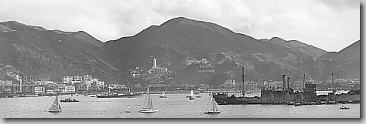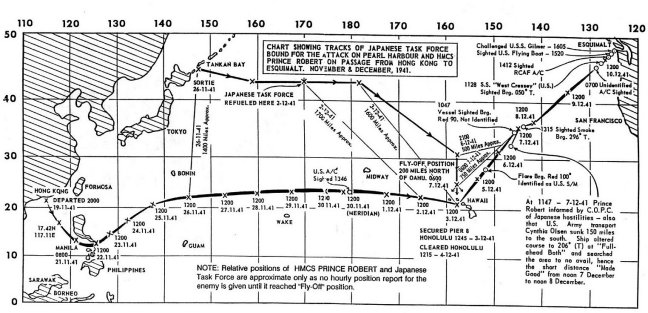
HILLMAN WWII SCRAPBOOK
HMCS PRINCE ROBERT
www.hillmanweb.com/rcn
http://www.hillmanweb.com/rcn/prstory04.html
Presents
4. HONG KONG 1941
CDR. F. G. HART R.C.N. 8.10.1940

The ROBERT then returned to patrol the South Pacific off the coasts of South America from Mexico to the straits of Magellan. During this period, stops were made at Callao, Antofagasta, Concepcion, and for 24 hours on Christmas day at Valaparaiso. A fast trip was then made to Easter Island in search of a reported German raider but nothing was found. Later in the spring of 1941 saw the ROBERT attached to New Zealand as convoy protection for the airmen coming to Canada for the Commonwealth Air Training Plan.The ROBERT refitted at Esquimalt during the summer of 1941 and on October 27th, sailed as escort for the AWATEA carrying Canadian troops to Hong Kong. The ROBERT carried four officers and 105 ranks of the Royal Rifles while AWATEA carried the remainder, along with the Winnipeg Grenadiers. The total contingent, Force “C” consisted of 96 officers, 1,877 other ranks, tow auxiliary Service Supervisors and one stowaway. The latter fortunately made the round trip, as the entire force was lost when Hong Kong fell a month later. Many of those captured subsequently died in Japanese prison camps.
The ships had sailed the night of October 27th via Honolulu and Manila where HMS DANAE was added to the escort. They reached Hong Kong on November 16th, and the ROBERT started the return journey a week later. She passed through Honolulu December 3rd, without an inkling of the Japanese task force already on the way to Pearl Harbor. There were of course rumours (much after the fact) of mystifying signals picked up, but since it is now known that the Japanese task force steamed through the North Pacific under strict radio silence, the rumours are laid.
Four hours after the Pearl Harbor attack, a message was received aboard the ROBERT that the U.S. Navy transport CYNTHIA OLSEN had been torpedoed about 130 miles south of her position. She diverted, searched the sea, but found nothing.


Mr. Hillman, |



Webmaster: William G. Hillman
BILL & SUE-ON HILLMAN ECLECTIC STUDIO
Copyright 2000/2006/2017
Bill Johnson Material Copyright 1988